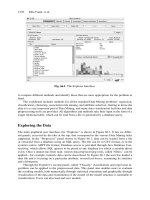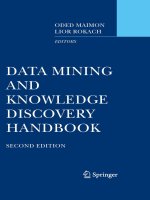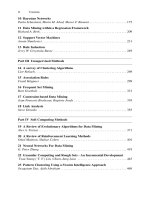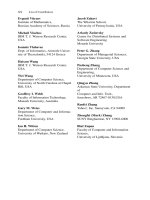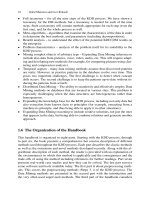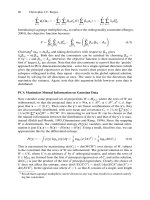Data Mining and Knowledge Discovery Handbook, 2 Edition part 100 potx
Bạn đang xem bản rút gọn của tài liệu. Xem và tải ngay bản đầy đủ của tài liệu tại đây (101.5 KB, 10 trang )
970 Lior Rokach
base classifiers present diverse classifications. This arbiter, together with an arbitration rule,
decides on a final classification outcome, based upon the base predictions. Figure 50.6 shows
how the final classification is selected based on the classification of two base classifiers and a
single arbiter.
Classifier 1
Classifier 2
Arbiter
Instance
Arbitration
Rule
Final
ClassificationClassification
Arbiter
Classification
Classification
Fig. 50.6. A Prediction from Two Base Classifiers and a Single Arbiter.
The process of forming the union of data subsets; classifying it using a pair of arbiter
trees; comparing the classifications; forming a training set; training the arbiter; and picking
one of the predictions, is recursively performed until the root arbiter is formed. Figure 50.7
illustrate an arbiter tree created for k = 4. T
1
−T
4
are the initial four training datasets from
which four classifiers C
1
−C
4
are generated concurrently. T
12
and T
34
are the training sets
generated by the rule selection from which arbiters are produced. A
12
and A
34
are the two
arbiters. Similarly, T
14
and A
14
(root arbiter) are generated and the arbiter tree is completed.
A
14
A
12
T
12
T
1
T
2
T
3
T
4
T
34
C
1
C
2
C
3
C
4
A
34
Arbiters
Classifiers
Data-subsets
Fig. 50.7. Sample Arbiter Tree.
Several schemes for arbiter trees were examined and differentiated from each other by the
selection rule used. Here are three versions of rule selection:
• Only instances with classifications that disagree are chosen (group 1).
• Like group 1 defined above, plus instances that their classifications agree but are incorrect
(group 2).
• Like groups 1 and 2 defined above, plus instances that have the same correct classifications
(group 3).
50 Ensemble Methods in Supervised Learning 971
Two versions of arbitration rules have been implemented; each one corresponds to the selec-
tion rule used for generating the training data at that level:
• For selection rule 1 and 2, a final classification is made by a majority vote of the classifi-
cations of the two lower levels and the arbiter’s own classification, with preference given
to the latter.
• For selection rule 3, if the classifications of the two lower levels are not equal, the clas-
sification made by the sub-arbiter based on the first group is chosen. In case this is not
true and the classification of the sub-arbiter constructed on the third group equals those of
the lower levels — then this is the chosen classification. In any other case, the classifica-
tion of the sub-arbiter constructed on the second group is chosen. Chan and Stolfo (1993)
achieved the same accuracy level as in the single mode applied to the entire dataset but
with less time and memory requirements. It has been shown that this meta-learning strat-
egy required only around 30% of the memory used by the single model case. This last
fact, combined with the independent nature of the various learning processes, make this
method robust and effective for massive amounts of data. Nevertheless, the accuracy level
depends on several factors such as the distribution of the data among the subsets and
the pairing scheme of learned classifiers and arbiters in each level. The decision in any
of these issues may influence performance, but the optimal decisions are not necessarily
known in advance, nor initially set by the algorithm.
Combiner Trees
The way combiner trees are generated is very similar to arbiter trees. A combiner tree is
trained bottom-up. However, a combiner, instead of an arbiter, is placed in each non-leaf node
of a combiner tree (Chan and Stolfo, 1997). In the combiner strategy, the classifications of
the learned base classifiers form the basis of the meta-learner’s training set. A composition
rule determines the content of training examples from which a combiner (meta-classifier) will
be generated. In classifying an instance, the base classifiers first generate their classifications
and based on the composition rule, a new instance is generated. The aim of this strategy is
to combine the classifications from the base classifiers by learning the relationship between
these classifications and the correct classification. Figure 50.8 illustrates the result obtained
from two base classifiers and a single combiner.
Classifier 1
Classifier 2
Instance
Combiner
Final
Classification
Classification 2
Classification 1
Fig. 50.8. A Prediction from Two Base Classifiers and a Single Combiner.
Two schemes of composition rule were proposed. The first one is the stacking schema. The
second is like stacking with the addition of the instance input attributes. Chan and Stolfo (1995)
972 Lior Rokach
showed that the stacking schema per se does not perform as well as the second schema. Al-
though there is information loss due to data partitioning, combiner trees can sustain the accu-
racy level achieved by a single classifier. In a few cases, the single classifier’s accuracy was
consistently exceeded.
Grading
This technique uses “graded” classifications as meta-level classes (Seewald and Furnkranz,
2001). The term graded is used in the sense of classifications that have been marked as correct
or incorrect. The method transforms the classification made by the k different classifiers into
k training sets by using the instances k times and attaching them to a new binary class in
each occurrence. This class indicates whether the k–th classifier yielded a correct or incorrect
classification, compared to the real class of the instance.
For each base classifier, one meta-classifier is learned whose task is to classify when the
base classifier will misclassify. At classification time, each base classifier classifies the unla-
beled instance. The final classification is derived from the classifications of those base classi-
fiers that are classified to be correct by the meta-classification schemes. In case several base
classifiers with different classification results are classified as correct, voting, or a combina-
tion considering the confidence estimates of the base classifiers, is performed. Grading may
be considered as a generalization of cross-validation selection (Schaffer, 1993), which divides
the training data into k subsets, builds k −1 classifiers by dropping one subset at a time and
then using it to find a misclassification rate. Finally, the procedure simply chooses the clas-
sifier corresponding to the subset with the smallest misclassification. Grading tries to make
this decision separately for each and every instance by using only those classifiers that are
predicted to classify that instance correctly. The main difference between grading and com-
biners (or stacking) are that the former does not change the instance attributes by replacing
them with class predictions or class probabilities (or adding them to it). Instead it modifies the
class values. Furthermore, in grading several sets of meta-data are created, one for each base
classifier. Several meta-level classifiers are learned from those sets.
The main difference between grading and arbiters is that arbiters use information about
the disagreements of classifiers for selecting a training set, while grading uses disagreement
with the target function to produce a new training set.
50.5 Ensemble Diversity
In an ensemble, the combination of the output of several classifiers is only useful if they
disagree about some inputs (Tumer and Ghosh, 1996). According to Hu (2001) diversified
classifiers lead to uncorrelated errors, which in turn improve classification accuracy.
50.5.1 Manipulating the Inducer
A simple method for gaining diversity is to manipulate the inducer used for creating the clas-
sifiers. Ali and Pazzani (1996) propose to change the rule learning HYDRA algorithm in the
following way: Instead of selecting the best literal in each stage (using, for instance, informa-
tion gain measure), the literal is selected randomly such that its probability of being selected
is proportional to its measure value. Dietterich (2000a) has implemented a similar idea for
C4.5 decision trees. Instead of selecting the best attribute in each stage, it selects randomly
50 Ensemble Methods in Supervised Learning 973
(with equal probability) an attribute from the set of the best 20 attributes. The simplest way
to manipulate the back-propagation inducer is to assign different initial weights to the net-
work (Kolen and Pollack, 1991). MCMC (Markov Chain Monte Carlo) methods can also be
used for introducing randomness in the induction process (Neal, 1993).
50.5.2 Manipulating the Training Set
Most ensemble methods construct the set of classifiers by manipulating the training instances.
Dietterich (2000b) distinguishes between three main methods for manipulating the dataset.
Manipulating the Tuples
In this method, each classifier is trained on a different subset of the original dataset. This
method is useful for inducers whose variance-error factor is relatively large (such as decision
trees and neural networks), namely, small changes in the training set may cause a major change
in the obtained classifier. This category contains procedures such as bagging, boosting and
cross-validated committees.
The distribution of tuples among the different subsets could be random as in the bagging
algorithm or in the arbiter trees. Other methods distribute the tuples based on the class distri-
bution such that the class distribution in each subset is approximately the same as that in the
entire dataset. Proportional distribution was used in combiner trees (Chan and Stolfo, 1993).
It has been shown that proportional distribution can achieve higher accuracy than random
distribution.
Recently Christensen et al. (2004) suggest a novel framework for construction of an en-
semble in which each instance contributes to the committee formation with a fixed weight,
while contributing with different individual weights to the derivation of the different con-
stituent models. This approach encourages model diversity whilst not biasing the ensemble
inadvertently towards any particular instance.
Manipulating the Input Feature Set
Another less common strategy for manipulating the training set is to manipulate the input
attribute set. The idea is to simply give each classifier a different projection of the training set.
50.5.3 Measuring the Diversity
For regression problems variance is usually used to measure diversity
(Krogh and Vedelsby, 1995). In such cases it can be easily shown that the ensemble error
can be reduced by increasing ensemble diversity while maintaining the average error of a
single model.
In classification problems, a more complicated measure is required to evaluate the diver-
sity. Kuncheva and Whitaker (2003) compared several measures of diversity and concluded
that most of them are correlated. Furthermore, it is usually assumed that increasing diversity
may decrease ensemble error (Zenobi and Cunningham, 2001).
974 Lior Rokach
50.6 Ensemble Size
50.6.1 Selecting the Ensemble Size
An important aspect of ensemble methods is to define how many component classifiers should
be used. This number is usually defined according to the following issues:
• Desired accuracy — Hansen (1990) argues that ensembles containing ten classifiers is
sufficient for reducing the error rate. Nevertheless, there is empirical evidence indicat-
ing that in the case of AdaBoost using decision trees, error reduction is observed in even
relatively large ensembles containing 25 classifiers (Opitz and Maclin, 1999). In the dis-
joint partitioning approaches, there may be a tradeoff between the number of subsets and
the final accuracy. The size of each subset cannot be too small because sufficient data
must be available for each learning process to produce an effective classifier. Chan and
Stolfo (1993) varied the number of subsets in the arbiter trees from 2 to 64 and examined
the effect of the predetermined number of subsets on the accuracy level.
• User preferences — Increasing the number of classifiers usually increase computational
complexity and decreases the comprehensibility. For that reason, users may set their pref-
erences by predefining the ensemble size limit.
• Number of processors available — In concurrent approaches, the number of processors
available for parallel learning could be put as an upper bound on the number of classifiers
that are treated in paralleled process.
Caruana et al. (2004) presented a method for constructing ensembles from libraries of
thousands of models. They suggest using forward stepwise selection in order to select the
models that maximize the ensemble’s performance. Ensemble selection allows ensembles to
be optimized to performance metrics such as accuracy, cross entropy, mean precision, or ROC
Area.
50.6.2 Pruning Ensembles
As in decision trees induction, it is sometime useful to let the ensemble grow freely and then
prune the ensemble in order to get more effective and more compact ensembles. Empirical
examinations indicate that pruned ensembles may obtain a similar accuracy performance as
the original ensemble (Margineantu and Dietterich, 1997).
The efficiency of pruning methods when meta-combining methods are used have been
examined in (Prodromidis et al., 2000). In such cases the pruning methods can be divided into
two groups: pre-training pruning methods and post-training pruning methods. Pre-training
pruning is performed before combining the classifiers. Classifiers that seem to be attractive
are included in the meta-classifier. On the other hand, post-training pruning methods, remove
classifiers based on their effect on the meta-classifier. Three methods for pre-training prun-
ing (based on an individual classification performance on a separate validation set, diversity
metrics, the ability of classifiers to classify correctly specific classes) and two methods for
post-training pruning (based on decision tree pruning and the correlation of the base clas-
sifier to the unpruned meta-classifier) have been examined in (Prodromidis et al., 2000). As
in (Margineantu and Dietterich, 1997), it has been shown that by using pruning, one can obtain
similar or better accuracy performance, while compacting the ensemble.
The GASEN algorithm was developed for selecting the most appropriate classifiers in
a given ensemble (Zhou et al., 2002). In the initialization phase, GASEN assigns a random
50 Ensemble Methods in Supervised Learning 975
weight to each of the classifiers. Consequently, it uses genetic algorithms to evolve those
weights so that they can characterize to some extent the fitness of the classifiers in joining
the ensemble. Finally, it removes from the ensemble those classifiers whose weight is less
than a predefined threshold value. Recently a revised version of the GASEN algorithm called
GASEN-b has been suggested (Zhou and Tang, 2003). In this algorithm, instead of assigning
a weight to each classifier, a bit is assigned to each classifier indicating whether it will be used
in the final ensemble. They show that the obtained ensemble is not only smaller in size, but in
some cases has better generalization performance.
Liu et al. (2004) conducted an empirical study of the relationship of ensemble sizes with
ensemble accuracy and diversity, respectively. They show that it is feasible to keep a small
ensemble while maintaining accuracy and diversity similar to those of a full ensemble. They
proposed an algorithm called LV F d that selects diverse classifiers to form a compact ensem-
ble.
50.7 Cluster Ensemble
This chapter focused mainly on ensembles of classifiers. However ensemble methodology can
be used for other Data Mining tasks such as regression and clustering.
The cluster ensemble problem refers to the problem of combining multiple partitionings
of a set of instances into a single consolidated clustering. Usually this problem is formalized
as a combinatorial optimization problem in terms of shared mutual information.
Dimitriadou et al. (2003) have used ensemble methodology for improving the quality and
robustness of clustering algorithms. In fact they employ the same ensemble idea that has been
used for many years in classification and regression tasks. More specifically they suggested
various aggregation strategies and studied a greedy forward aggregation.
Hu and Yoo (2004) have used ensemble for clustering gene expression data. In this re-
search the clustering results of individual clustering algorithms are converted into a distance
matrix. These distance matrices are combined and a weighted graph is constructed according
to the combined matrix. Then a graph partitioning approach is used to cluster the graph to
generate the final clusters.
Strehl and Ghosh (2003) propose three techniques for obtaining high-quality cluster com-
biners. The first combiner induces a similarity measure from the partitionings and then reclus-
ters the objects. The second combiner is based on hypergraph partitioning. The third one col-
lapses groups of clusters into meta-clusters, which then compete for each object to determine
the combined clustering. Moreover, it is possible to use supra-combiners that evaluate all three
approaches against the objective function and pick the best solution for a given situation.
In summary, the methods presented in this chapetr are useful for many application do-
mains, such as: Manufacturing lr18,lr14, Security lr7,l10 and Medicine lr2,lr9, and for many
data mining techniques, such as: decision trees lr6,lr12, lr15, clustering lr13,lr8,lr5,lr16 and
genetic algorithms lr17,lr11,lr1,lr4.
References
Ali K. M., Pazzani M. J., Error Reduction through Learning Multiple Descriptions, Machine
Learning, 24: 3, 173-202, 1996.
976 Lior Rokach
Arbel, R. and Rokach, L., Classifier evaluation under limited resources, Pattern Recognition
Letters, 27(14): 1619–1631, 2006, Elsevier.
Averbuch, M. and Karson, T. and Ben-Ami, B. and Maimon, O. and Rokach, L., Context-
sensitive medical information retrieval, The 11th World Congress on Medical Informat-
ics (MEDINFO 2004), San Francisco, CA, September 2004, IOS Press, pp. 282–286.
Bartlett P. and Shawe-Taylor J., Generalization Performance of Support Vector Machines
and Other Pattern Classifiers, In “Advances in Kernel Methods, Support Vector Learn-
ing”, Bernhard Scholkopf, Christopher J. C. Burges, and Alexander J. Smola (eds.), MIT
Press, Cambridge, USA, 1998.
Bauer, E. and Kohavi, R., “An Empirical Comparison of Voting Classification Algorithms:
Bagging, Boosting, and Variants”. Machine Learning, 35: 1-38, 1999.
Breiman L., Bagging predictors, Machine Learning, 24(2):123-140, 1996.
Bruzzone L., Cossu R., Vernazza G., Detection of land-cover transitions by combining mul-
tidate classifiers, Pattern Recognition Letters, 25(13): 1491–1500, 2004.
Buchanan, B.G. and Shortliffe, E.H., Rule Based Expert Systems, 272-292, Addison-Wesley,
1984.
Buhlmann, P. and Yu, B., Boosting with L
2
loss: Regression and classification, Journal of the
American Statistical Association, 98, 324338. 2003.
Buntine, W., A Theory of Learning Classification Rules. Doctoral dissertation. School of
Computing Science, University of Technology. Sydney. Australia, 1990.
Caruana R., Niculescu-Mizil A. , Crew G. , Ksikes A., Ensemble selection from libraries of
models, Twenty-first international conference on Machine learning, July 04-08, 2004,
Banff, Alberta, Canada.
Chan P. K. and Stolfo, S. J., Toward parallel and distributed learning by meta-learning, In
AAAI Workshop in Knowledge Discovery in Databases, pp. 227-240, 1993.
Chan P.K. and Stolfo, S.J., A Comparative Evaluation of Voting and Meta-learning on Parti-
tioned Data, Proc. 12th Intl. Conf. On Machine Learning ICML-95, 1995.
Chan P.K. and Stolfo S.J, On the Accuracy of Meta-learning for Scalable Data Mining, J.
Intelligent Information Systems, 8:5-28, 1997.
Charnes, A., Cooper, W. W., and Rhodes, E., Measuring the efficiency of decision making
units, European Journal of Operational Research, 2(6):429-444, 1978.
Christensen S. W. , Sinclair I., Reed P. A. S., Designing committees of models through delib-
erate weighting of data points, The Journal of Machine Learning Research, 4(1):39–66,
2004.
Clark, P. and Boswell, R., “Rule induction with CN2: Some recent improvements.” In Pro-
ceedings of the European Working Session on Learning, pp. 151-163, Pitman, 1991.
Cohen S., Rokach L., Maimon O., Decision Tree Instance Space Decomposition with
Grouped Gain-Ratio, Information Science, Volume 177, Issue 17, pp. 3592-3612, 2007.
D
ˇ
zeroski S.,
ˇ
Zenko B., Is Combining Classifiers with Stacking Better than Selecting the Best
One?, Machine Learning, 54(3): 255–273, 2004.
Dietterich, T. G., An Experimental Comparison of Three Methods for Constructing Ensem-
bles of Decision Trees: Bagging, Boosting and Randomization. 40(2):139-157, 2000.
Dietterich T., Ensemble methods in machine learning. In J. Kittler and F. Roll, editors, First
International Workshop on Multiple Classifier Systems, Lecture Notes in Computer Sci-
ence, pages 1-15. Springer-Verlag, 2000
Dimitriadou E., Weingessel A., Hornik K., A cluster ensembles framework, Design and ap-
plication of hybrid intelligent systems, IOS Press, Amsterdam, The Netherlands, 2003.
Domingos, P., Using Partitioning to Speed Up Specific-to-General Rule Induction. In Pro-
ceedings of the AAAI-96 Workshop on Integrating Multiple Learned Models, pp. 29-34,
AAAI Press, 1996.
50 Ensemble Methods in Supervised Learning 977
Freund Y. and Schapire R. E., Experiments with a new boosting algorithm. In Machine
Learning: Proceedings of the Thirteenth International Conference, pages 325-332, 1996.
F
¨
urnkranz, J., More efficient windowing, In Proceeding of The 14th national Conference on
Artificial Intelegence (AAAI-97), pp. 509-514, Providence, RI. AAAI Press, 1997.
Gams, M., New Measurements Highlight the Importance of Redundant Knowledge. In Eu-
ropean Working Session on Learning, Montpeiller, France, Pitman, 1989.
Geman S., Bienenstock, E., and Doursat, R., Neural networks and the bias
variance dilemma. Neural Computation, 4:1-58, 1995.
Hansen J., Combining Predictors. Meta Machine Learning Methods and Bias
Variance & Ambiguity Decompositions. PhD dissertation. Aurhus University. 2000.
Hansen, L. K., and Salamon, P., Neural network ensembles. IEEE Transactions on Pattern
Analysis and Machine Intelligence, 12(10), 993–1001, 1990.
Hu, X., Using Rough Sets Theory and Database Operations to Construct a Good Ensemble
of Classifiers for Data Mining Applications. ICDM01. pp. 233-240, 2001.
Hu X., Yoo I., Cluster ensemble and its applications in gene expression analysis, Proceedings
of the second conference on Asia-Pacific bioinformatics, pp. 297–302, Dunedin, New
Zealand, 2004.
Kolen, J. F., and Pollack, J. B., Back propagation is sesitive to initial conditions. In Ad-
vances in Neural Information Processing Systems, Vol. 3, pp. 860-867 San Francisco,
CA. Morgan Kaufmann, 1991.
Krogh, A., and Vedelsby, J., Neural network ensembles, cross validation and active learning.
In Advances in Neural Information Processing Systems 7, pp. 231-238 1995.
Kuncheva, L., & Whitaker, C., Measures of diversity in classifier ensembles and their rela-
tionship with ensemble accuracy. Machine Learning, pp. 181–207, 2003.
Leigh W., Purvis R., Ragusa J. M., Forecasting the NYSE composite index with technical
analysis, pattern recognizer, neural networks, and genetic algorithm: a case study in ro-
mantic decision support, Decision Support Systems 32(4): 361–377, 2002.
Lewis D., and Catlett J., Heterogeneous uncertainty sampling for supervised learning. In
Machine Learning: Proceedings of the Eleventh Annual Conference, pp. 148-156 , New
Brunswick, New Jersey, Morgan Kaufmann, 1994.
Lewis, D., and Gale, W., Training text classifiers by uncertainty sampling, In seventeenth an-
nual international ACM SIGIR conference on research and development in information
retrieval, pp. 3-12, 1994.
Liu H., Mandvikar A., Mody J., An Empirical Study of Building Compact Ensembles. WAIM
2004: pp. 622-627.
Maimon O., and Rokach, L. Data Mining by Attribute Decomposition with semiconductors
manufacturing case study, in Data Mining for Design and Manufacturing: Methods and
Applications, D. Braha (ed.), Kluwer Academic Publishers, pp. 311–336, 2001.
Maimon O. and Rokach L., “Improving supervised learning by feature decomposition”, Pro-
ceedings of the Second International Symposium on Foundations of Information and
Knowledge Systems, Lecture Notes in Computer Science, Springer, pp. 178-196, 2002.
Maimon O. Rokach L., Ensemble of Decision Trees for Mining Manufacturing Data Sets,
Machine Engineering, vol. 4 No1-2, 2004.
Maimon, O. and Rokach, L., Decomposition Methodology for Knowledge Discovery and
Data Mining: Theory and Applications, Series in Machine Perception and Artificial In-
telligence - Vol. 61, World Scientific Publishing, ISBN:981-256-079-3, 2005.
Mangiameli P., West D., Rampal R., Model selection for medical diagnosis decision support
systems, Decision Support Systems, 36(3): 247–259, 2004.
978 Lior Rokach
Margineantu D. and Dietterich T., Pruning adaptive boosting. In Proc. Fourteenth Intl. Conf.
Machine Learning, pages 211–218, 1997.
Mitchell, T., Machine Learning, McGraw-Hill, 1997.
Moskovitch R, Elovici Y, Rokach L, Detection of unknown computer worms based on behav-
ioral classification of the host, Computational Statistics and Data Analysis, 52(9):4544–
4566, 2008.
Neal R., Probabilistic inference using Markov Chain Monte Carlo methods. Tech. Rep. CRG-
TR-93-1, Department of Computer Science, University of Toronto, Toronto, CA, 1993.
Opitz, D. and Maclin, R., Popular Ensemble Methods: An Empirical Study, Journal of Arti-
ficial Research, 11: 169-198, 1999.
Parmanto, B., Munro, P. W., and Doyle, H. R., Improving committee diagnosis with resam-
pling techinques. In Touretzky, D. S., Mozer, M. C., and Hesselmo, M. E. (Eds). Ad-
vances in Neural Information Processing Systems, Vol. 8, pp. 882-888 Cambridge, MA.
MIT Press, 1996.
Prodromidis, A. L., Stolfo, S. J. and Chan, P. K., Effective and efficient pruning of metaclas-
sifiers in a distributed Data Mining system. Technical report CUCS-017-99, Columbia
Univ., 1999.
Provost, F.J. and Kolluri, V., A Survey of Methods for Scaling Up Inductive Learning Algo-
rithms, Proc. 3rd International Conference on Knowledge Discovery and Data Mining,
1997.
Quinlan, J. R., C4.5: Programs for Machine Learning, Morgan Kaufmann, Los Altos, 1993.
Quinlan, J. R., Bagging, Boosting, and C4.5. In Proceedings of the Thirteenth National Con-
ference on Artificial Intelligence, pages 725-730, 1996.
Rokach, L., Decomposition methodology for classification tasks: a meta decomposer frame-
work, Pattern Analysis and Applications, 9(2006):257–271.
Rokach L., Genetic algorithm-based feature set partitioning for classification prob-
lems,Pattern Recognition, 41(5):1676–1700, 2008.
Rokach L., Mining manufacturing data using genetic algorithm-based feature set decompo-
sition, Int. J. Intelligent Systems Technologies and Applications, 4(1):57-78, 2008.
Rokach, L. and Maimon, O., Theory and applications of attribute decomposition, IEEE In-
ternational Conference on Data Mining, IEEE Computer Society Press, pp. 473–480,
2001.
Rokach L. and Maimon O., Feature Set Decomposition for Decision Trees, Journal of Intel-
ligent Data Analysis, Volume 9, Number 2, 2005b, pp 131–158.
Rokach, L. and Maimon, O., Clustering methods, Data Mining and Knowledge Discovery
Handbook, pp. 321–352, 2005, Springer.
Rokach, L. and Maimon, O., Data mining for improving the quality of manufacturing: a
feature set decomposition approach, Journal of Intelligent Manufacturing, 17(3):285–
299, 2006, Springer.
Rokach, L., Maimon, O., Data Mining with Decision Trees: Theory and Applications, World
Scientific Publishing, 2008.
Rokach L., Maimon O. and Lavi I., Space Decomposition In Data Mining: A Clustering Ap-
proach, Proceedings of the 14th International Symposium On Methodologies For Intel-
ligent Systems, Maebashi, Japan, Lecture Notes in Computer Science, Springer-Verlag,
2003, pp. 24–31.
Rokach, L. and Maimon, O. and Averbuch, M., Information Retrieval System for Medical
Narrative Reports, Lecture Notes in Artificial intelligence 3055, page 217-228 Springer-
Verlag, 2004.
50 Ensemble Methods in Supervised Learning 979
Rokach, L. and Maimon, O. and Arbel, R., Selective voting-getting more for less in sensor
fusion, International Journal of Pattern Recognition and Artificial Intelligence 20 (3)
(2006), pp. 329–350.
Schaffer, C., Selecting a classification method by cross-validation. Machine Learning
13(1):135-143, 1993.
Seewald, A.K. and F
¨
urnkranz, J., Grading classifiers, Austrian research institute for Artificial
intelligence, 2001.
Sharkey, A., On combining artificial neural nets, Connection Science, Vol. 8, pp.299-313,
1996.
Shilen, S., Multiple binary tree classifiers. Pattern Recognition 23(7): 757-763, 1990.
Shilen, S., Nonparametric classification using matched binary decision trees. Pattern Recog-
nition Letters 13: 83-87, 1992.
Sohn S. Y., Choi, H., Ensemble based on Data Envelopment Analysis, ECML Meta Learning
workshop, Sep. 4, 2001.
Strehl A., Ghosh J. (2003), Cluster ensembles - a knowledge reuse framework for combining
multiple partitions, The Journal of Machine Learning Research, 3: 583-617, 2003.
Tan A. C., Gilbert D., Deville Y., Multi-class Protein Fold Classification using a New En-
semble Machine Learning Approach. Genome Informatics, 14:206–217, 2003.
Tukey J.W., Exploratory data analysis, Addison-Wesley, Reading, Mass, 1977.
Tumer, K. and Ghosh J., Error Correlation and Error Reduction in Ensemble Classifiers,
Connection Science, Special issue on combining artificial neural networks: ensemble
approaches, 8 (3-4): 385-404, 1996.
Tumer, K., and Ghosh J., Linear and Order Statistics Combiners for Pattern Classification, in
Combining Articial Neural Nets, A. Sharkey (Ed.), pp. 127-162, Springer-Verlag, 1999.
Tumer, K., and Ghosh J., Robust Order Statistics based Ensembles for Distributed Data Min-
ing. In Kargupta, H. and Chan P., eds, Advances in Distributed and Parallel Knowledge
Discovery , pp. 185-210, AAAI/MIT Press, 2000.
Wolpert, D.H., Stacked Generalization, Neural Networks, Vol. 5, pp. 241-259, Pergamon
Press, 1992.
Zenobi, G., and Cunningham, P. Using diversity in preparing ensembles of classifiers based
on different feature subsets to minimize generalization error. In Proceedings of the Eu-
ropean Conference on Machine Learning, 2001.
Zhou, Z. H., and Tang, W., Selective Ensemble of Decision Trees, in Guoyin Wang, Qing Liu,
Yiyu Yao, Andrzej Skowron (Eds.): Rough Sets, Fuzzy Sets, Data Mining, and Granular
Computing, 9
th
International Conference, RSFDGrC, Chongqing, China, Proceedings.
Lecture Notes in Computer Science 2639, pp.476-483, 2003.
Zhou, Z. H., Wu J., Tang W., Ensembling neural networks: many could be better than all.
Artificial Intelligence 137: 239-263, 2002.
